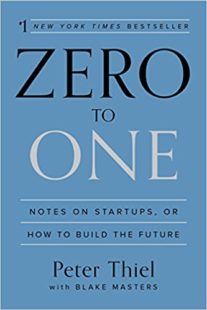Everyone loves a good startup story that inspires you to get on your feet and pursue that million-dollar idea that’s been on the back-burner for years now.
Many startup stories are similar, but the ones we have for you today are the kind that happens once in a lifetime. Seriously, if the proof weren’t right in front of us, we wouldn’t believe the success that these people stumbled upon.
Today, we’re going to be telling about three amazing startup stories that are almost too good to be true! From celebrities endorsing their products to becoming billionaires after years of being homeless.

Zero to One
by Peter Thiel
⏱ 12 minutes reading time
🎧 Audio version available
Sara Blakely
Kicking off our amazing startup stories, we have the origins of the final product you would think had humble beginnings: Spanx. There’s an insanely interesting and inspiring story behind the elastic product.
Spanx is a product that was created by Sara Blakely. The start of this startup takes us to the year 1998. Sara was in a stump in her life. She was struggling to sell fax machines door to door in Florida. Before this, she tried to be an attorney, worked at Disney, then randomly enough, was a stand-up comedian for some time.
Wherever she worked, and whenever she wore light-colored slacks, she grew annoyed with the panty lines that always showed. After too many fashion faux-pas, she decided one day to cut off the feet of a pair of pantyhose and wear them under her pants. And that’s how the idea for Spanx was born.
But just because you– or Sara, in this case, had a billion-dollar idea, doesn’t mean she didn’t need help taking her brand off the ground. But here’s how Sara’s story wildly differentiates from everyone else. The unbelievable part came in when Oprah made her Spanx product famous!
But this is getting ahead of the subject. Before Oprah’s Midas touch touched Sara’s product, Blakely started working nights and on weekends to visit manufacturers, research patents, and settle on a prototype.
She was working at a company called Danka, and for the next two years, she spent a total of $5,000 of her savings in research and development.
She was 27 years old when she drove up to North Carolina, the capital of where most of America’s hosiery mills are located. And get this: every representative rejected her hosiery idea. These companies refused to deal with someone who wasn’t an established company, so the value of her idea went over their heads.
But all hope was not lost. Blakely went home, and two weeks later, she unexpectedly received a call from a male mill operator in Asheboro, North Carolina. He told her that his three daughters loved the idea, so he wanted to support Blakely.
Blakely then used her own credit card to purchase the trademark “Spanx” on the USPTO website for $150. One of the most defining moments of her startup occurred when Blakely scored a meeting with a representative of the Neiman Marcus Group. To show her persistence, Blakely went to the ladies’ restroom to change into the product to prove its benefits.
Seven Neiman Marcus stores picked up her product as a result of this innovative meeting. Then shops like Saks, Bloomingdales, and Bergdorf Goodman followed.
Around this time, ambitiously, Blakely sent a basket of her products to Oprah Winfrey’s show with a gift card that detailed what she was trying to build off the ground.
Also, by this time, Blakely was handling all the business aspects of “Spanx.” That includes marketing, logistics, and product positioning. She wanted her product to be sold alongside shoes in retail outlets rather than in the hosiery sections.
Left and right, Blakely contacted friends and acquaintances from the present and the past, asking them to buy her products from department stores, offering them a check that she would send to them by mail to show her gratitude.
Then, on a legendary day in November 2000, Oprah Winfrey named Spanx a “Favorite Thing,” which wildly skyrocketed its popularity and sales. In Spanx’s first year of business, it earned a whopping $4 million. The second-year? $10 million.
In 2012, Blakely was a billionaire. If that’s not the ultimate startup goal, then I don’t know what is. Forbes magazine featured Blakeley on their cover for being the youngest self-made female billionaire in the world.
Is this story almost too good to be true? Imaging struggling to get your product to be picked up and having Oprah Winfrey offer you that chance of a gold platter? Never mind, earn $4 million in your first year of business.
Believe it or not, our next story is even more unbelievable because this person started with a lot less.
John Paul DeJoria
Coming in at number is this wild story of rags to riches like you have never seen before. Have you ever heard of the Patron Spirits tequila company?
And have you ever heard of the wild story behind it? Once upon a time, a startup whose creators, John Paul DeJoria, was homeless with only about $700 to his name.
DeJoria would sell encyclopedias door to door, pick up discarded bottles to cash in, all to feed himself and his son. So how did he go from that to being a billionaire entrepreneur? Strap in because this is a baffling story. One that ended up with one of DeJoria’s companies bringing in $900 million a month.
DeJoria went from showering at a public pool every day and picking out the cheapest meals in restaurants to being a billionaire by building an empire from the ground up. Before the idea of Patron kicked off, his million-dollar was “John Paul Mitchell Systems” hair products.
Haircare started to draw DeJoria’s interest when he worked as an entry-level employee in Redken Laboratories– which he was fired from. In 1980, with a $700 loan, he started John Paul Mitchell Systems with hairdresser Paul Mitchell. He was still living in a 20-year-old Rolls Royce.
Mitchell was already finding small success in selling his products. Still, he couldn’t get any reorders, so DeJoria stepped in and approached him about combining his business skills with Mitchell’s knowledge of hair care.
Together, they started their own company.
In the beginning, they managed to snag an investor that was supposed to give them $500,000, but he backed away.
The partners took to selling their products door to door and hairdressers.
Their product was a shampoo that only required one wash to save both time and money. They also had a conditioner that you left in, which acted as a heat protectant from blow dryers and neutralized chemicals on hairdressers’ hands.
Tragically, Paul Mitchell died of cancer not too long after the company started. DeJoria had to take over entirely.
DeJoria says that there’s no exact moment when he realized his business was a success, but it wasn’t until two years have passed that he was able to pay his bills on time.
Today, the company, which was based on a $700 loan, generated about $1 billion in annual revenue. Now, let’s look at DeJoria’s other amazingly successful company: Patron tequila.
DeJoria wanted tequila that you can sip on leisurely. Now, the company makes over two million cases each year.
Related: 5 Reasons You Should Start a Business In Your 30s
David Daneshgar
We saved the most unlikely story for last! The other two previous amazing stories were based on hard work and maybe one or two shoutouts from already successful people. Still, this particular startup story is the definition of “too good to be true.”
Here’s how David Daneshgar created a startup using money that he won from a poker tournament. He was a professional, so this may not apply to everyone, but everyone needs to listen to his story.
Daneshgar, along with two of his friends, had the idea to start an online marketplace that connected florists with customers. The one thing that stood in their way was their lack of startup cash.
So what happened?
Daneshgar signed up for the World Series of Poker in 2008. He paid $1000 to enter, and in one of the luckiest moments of his life, the grand prize money was $30,000– coincidentally the exact amount of money his startup needed.
The three friends went home with the $30,000 and launched their startup, BloomNation.
BloomNation became an online floral marketplace with over 3,500 florists that deliver to nearly 5,000 cities across the U.S. It’s kind of like an Etsy, but for flowers.
Customers are provided the means to connect with their local florists and see the flower arrangements beforehand. To show authenticity, florists upload photos of their beautiful flower arrangements as BloomNation doesn’t allow stock catalog images.
Also aiding BloomNation’s crazy success is that it was the first national floral website that accepted bitcoin.
See? Some entrepreneurs’ path to success may be a little rockier than others, and others may even experience smoother paths, but what they– and you– have in common, as well as Sara Blakely, John Dejario, and David Daneshgar, is that they persisted.
Just because something seems too good to be true doesn’t you shouldn’t continue to pour effort into it. Will you become the next amazing startup story that inspires future entrepreneurs?
What Is Snapreads?

With the Snapreads app, you get the key insights from the best nonfiction books in minutes, not hours or days. Our experts transform these books into quick, memorable, easy-to-understand insights you can read when you have the time or listen to them on the go.


